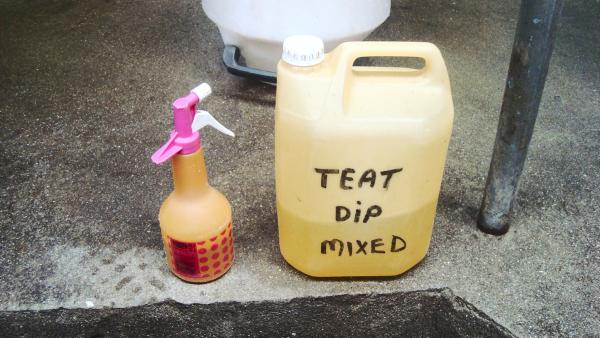The results of the 2013 Irish Farmers Journal annual farm input cost survey for milk parlour and hygiene product prices can be seen in Tables 1 to 7 (click link at bottom of page to see tables).
This survey is completed by farmers from across the country. Like all agricultural inputs, individual prices will depend on credit terms, along with group and bulk discounts. To properly compare the costs of some products, the dilution rate must be considered.
Antibiotic tubes
Once again, the prices paid for dry cow tubes, milking cow tubes and teat sealer all showed a substantial price range (Table 1). There was over €1/tube in the difference between the most expensive and the cheapest dry and milking cow tubes. The variation in active ingredients partly explains this.
Some tubes can contain up to three different antibiotics and, so, can combat more bacteria. These multi-antibiotic tubes tend to have longer withdrawal dates — a 120-hour post-calving milk withdrawal, for example.
When drying off cows, the average price paid by farmers using Cepravin tubes was €8.80/cow. However, the price paid by farmers ranged from a low of €6.80/cow to a high of €12.40/cow. That’s a difference of €5.60/cow or €560 over a 100-cow herd on dry cow tubes alone. The same is true for the next most popular dry cow tube in our survey, Terrexine. While the average price is €10.30/cow, the price paid by farmers ranged from €7.80 to €13.70, a difference of €5.90/cow.
Boviseal was the teat sealer of choice for most farmers and the only teat sealer with enough prices returned to allow us calculate an average. The average price paid for Boviseal was €5.30/cow but it ranged from €4.10/cow up to €7.80/cow. That’s a difference of €3.70, or €370 for a 100-cow herd.
In summary, our survey shows that a farmer treating a herd with antibiotics and sealer and paying the lower price for products could pay almost €1,000 less than the most expensive prices quoted, a saving of €10 per cow.
Liners and filters
The range in prices of milk liners is similar to last year. Depending on the product, sets of liners can be bought from a low of €15 to a high of €38 (Table 2). Table 3 shows the actual prices paid by farmers for different milk line filters. Again, you can see a wide range in the price paid depending on brand and size.
Detergents
The range of products used for washing milking machines never ceases to amaze me. Table 4 shows what the farmers in our survey use. You can see that there is a mixed choice, with many farmers buying 25-litre drums, some using buckets of powder and others buying large, 200-litre drums.
David Gleeson, Teagasc Moorepark, is trying to get farmers to purchase detergents based on the working solution.
He suggests that this is more important than price, especially if using with cold water.
He said: “The cheapest product may end up with the lowest working solution. Products with lower working solutions generally have lower concentrations of sodium hydroxide and hypochlorite, and are cheaper to make. Check the working solution in the Teagasc recommended list and relate it to the retail price.”
He explained detergent sterilisers are best used with hot water and, if used with cold water, then higher usage rates are necessary. In fact, in some instances, usage rates may be doubled and this can equate to the same cost of using hot water at night rate electricity.
Many farmers were using the same products for both machine and bulk tank washing (Tables 4 and 5).
Dilution rate and circulation requirements are two important considerations when comparing products. The more concentrated the circulating solution the greater the cost, as more concentrate is needed. The general circulation requirement is nine litres of solution per milking unit.
Buying in bulk volumes resulted in price savings, with the 200-litre drum cheaper than buying 20 to 25-litre drums. When purchasing a product for bulk tank or machine cleaning, make sure that it is on the Teagasc recommended list.
Descalers
Table 6 shows the products and prices of descalers used by farmers in the survey. A descaler should be used at least once a week if using a detergent wash. This will remove any residual material in milk lines which could potentially hold bacteria.
National teat dip list available
Teat disinfectants are used post milking to prevent mastitis. A number of these products may also be used pre-milking as part of the teat preparation process.
Other teat disinfectants are designed as an aid to teat cleaning, for use only before milking and are not effective when used after milking.
In response to requests for information on products, a list of all teat disinfectants available in Ireland has been compiled. This list indicates the information displayed on the drum labels, such as the trade name, main ingredients including emollient type where indicated, usage suitability (before or after disinfection), manufacturer name and registration status.
Teat disinfectant products are required to be registered and display either a pesticide control service (PCS) number or an Irish Medicine Board (IMB) number.
It is important that farmers purchase registered products. This also applies to milking machine cleaning products, as using unregistered products may have financial implications in a cross-compliance check.
The teat disinfectant product list is available on the Teagasc website.
Our survey of products used and prices (Table 7) again shows a large variation between farmers.
More and more farmers seem to be using large volume containers of pre-mixed product and the price of 200 litres varies from €172 (less than €1/litre) to over €450 per 200 litres for some products.





SHARING OPTIONS